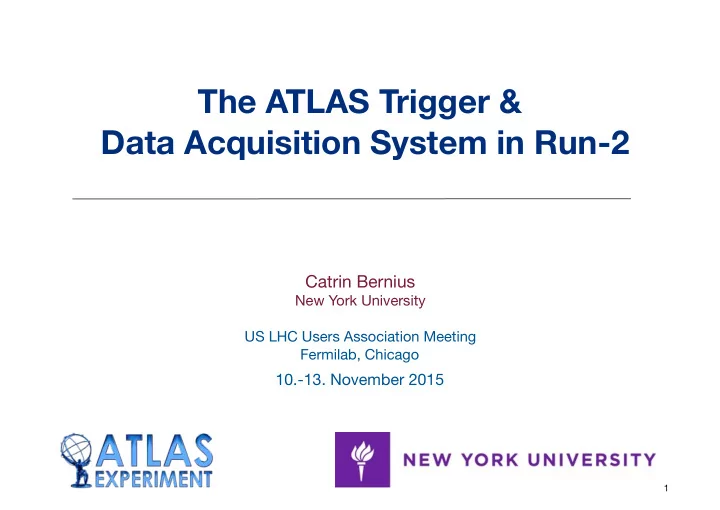

The ATLAS Trigger & Data Acquisition System in Run-2 Catrin Bernius New York University US LHC Users Association Meeting Fermilab, Chicago 10.-13. November 2015 1
From Run-1 to Run-2 The ATLAS trigger system operated successfully in Run-1 • Selected events online at √ s up to 8 TeV between 2009 and 2013 with high e ffi ciencies for a wide range of physics processes in ATLAS In Run-2, trigger rates are expected to increase by a factor of ~5 with the Run-1 trigger system: • A factor of ~2 due to the energy increase (higher for high p T jets) • A factor of 2-3 due to the luminosity increase Therefore, additional event rejection is needed via: • Increased trigger thresholds → potential loss of interesting physics • Increased trigger rejection power → improved hardware and software → Improvements & Upgrades to the TDAQ system and software necessary to help reduce the trigger rates to acceptable levels while maintaining or even improving selection e ffi ciencies in the challenging conditions!! 2 Plots taken from https://twiki.cern.ch/twiki/bin/view/ Catrin Bernius, NYU AtlasPublic/TriggerPublicResults
ATLAS TDAQ System - Run-2 Data Acquisition System: • gather data information from front end electronics from detector to build individual events • stores data to be sent to permanent storage • provides control, configuration and monitoring Trigger • multi-tiered system that decides which events to record • L1: custom electronics to determine Regions-of-Interest (RoIs) in the detector based on coarse calorimeter and muon information, rate reduction from ~ 30 MHz to 100 kHz • High Level Trigger (HLT): software algorithms running on RoIs or full event information, rate reduction from 100kHz to 1 kHz (1.5 kHz peak) 3 Catrin Bernius, NYU
New/Improved TDAQ System - Run-2 for Run-2 FE: Front End ROD: Read Out Device HW: HardWare DC: Data Collector RoI: Region of Interest BE: Back End ROS: ReadOut System EB: Event Builder SFO: SubFarm Output MUCTPI: Muon to Central Trigger Processor Interface TTC: Timing, Trigger Control CPM: Cluster Processor Module CMX: Common Merger eXtended Module CTP: Central Trigger Processor TP: Topological Processor nMCM: new Multi Chip Module PPM: Pre-Processor Module JEM: Jet Energy sum Module TCG: Thin Gap Chambers 4 Catrin Bernius, NYU
New/Improved TDAQ System - Run-2 for Run-2 FE: Front End ROD: Read Out Device HW: HardWare Rate reductions DC: Data Collector • New Multi-Chip Modules: dynamic pedestal subtraction based RoI: Region of Interest BE: Back End on global cell occupancy and position inside a bunch train, ROS: ReadOut System EB: Event Builder improved noise filters SFO: SubFarm Output MUCTPI: Muon to Central → significant reduction in L1 E Tmiss rates Trigger Processor Interface TTC: Timing, Trigger Control • New coincidence logic between inner muon chambers before toroid and extended barrel region of Tile calorimeter CPM: Cluster Processor Module → ~50% rate reduction for L1 muons with p T > 20 GeV at 25 ns CMX: Common Merger eXtended Module CTP: Central Trigger Processor TP: Topological Processor nMCM: new Multi Chip Module PPM: Pre-Processor Module JEM: Jet Energy sum Module TCG: Thin Gap Chambers 5 Catrin Bernius, NYU
New/Improved TDAQ System - Run-2 for Run-2 FE: Front End ROD: Read Out Device HW: HardWare DC: Data Collector RoI: Region of Interest BE: Back End ROS: ReadOut System EB: Event Builder SFO: SubFarm Output MUCTPI: Muon to Central L1 Topological Trigger Trigger Processor Interface TTC: Timing, Trigger Control • Programmable topological trigger selections • angular cuts, invariant mass cuts, etc CPM: Cluster Processor Module • Input from L1Calo and L1Muon CMX: Common Merger eXtended Module • Applies selection on trigger objects CTP: Central Trigger Processor TP: Topological Processor nMCM: new Multi Chip Module PPM: Pre-Processor Module → Low thresholds for multi-object JEM: Jet Energy sum Module final states possible TCG: Thin Gap Chambers 6 Catrin Bernius, NYU
Stable Beams - June 3 rd 2015 Followed by an overall very successful data-taking period for the ATLAS Trigger System! 7 Catrin Bernius, NYU
2015 Trigger Results • Electrons • New fast tracking algorithms • MVA energy calibration • Likelihood identification methods for HLT electron triggers • Muons: • major rewrite of standalone reconstruction for first muon identification step • redesigned muon full scan approach gaining factor of ~3 in speed with no e ffi ciency loss • transverse momentum calculation enhanced using hits from new chambers in endcaps → factor ~2 resolution improvement • Jets: • Excellent L1/HLT jet trigger performance • Implemented jet area pileup suppression and jet energy scale correction Plots taken from https:// twiki.cern.ch/twiki/bin/view/ AtlasPublic/ 8 Catrin Bernius, NYU TriggerPublicResults
2015 Trigger Results • Missing E T • Use of cell-level information immediately after L1 (coarse granularity used in Run-1) • Default cell-based algorithms with two-sided two-sigma noise suppression • Jet based algorithm with soft object correction (mht) • Multitude of topocluster-based algorithms with pileup suppression (pileup subtraction in rings of pseudo- rapidity (topocIPS), fit-based pileup correction (topocIPUC)) • Taus: • New fast tracking algorithms followed by full track reconstruction and a BDT-based selection using 13 pile-up corrected variables (calorimeter and tracking information) • Selections very close to those o ffl ine • Possible use of topological requirements between L1 objects (in commissioning) Plots taken from https:// twiki.cern.ch/twiki/bin/view/ AtlasPublic/ 9 Catrin Bernius, NYU TriggerPublicResults
2015 Trigger Results • Missing E T • Use of cell-level information immediately after L1 (coarse granularity used in Run-1) • Default cell-based algorithms with two-sided two-sigma noise suppression • Jet based algorithm with soft object correction (mht) • Multitude of topocluster-based algorithms with pileup suppression (pileup subtraction in rings of pseudo- Overall very successful first year of Run-2 rapidity (topocIPS), fit-based pileup correction (topocIPUC)) operation for the ATLAS Trigger System! Looking forward to the coming years! • Taus: • New fast tracking algorithms followed by full track reconstruction and a BDT-based selection using 13 pile-up corrected variables (calorimeter and tracking information) • Selections very close to those o ffl ine • Possible use of topological requirements between L1 objects (in commissioning) 10 Catrin Bernius, NYU
Recommend
More recommend